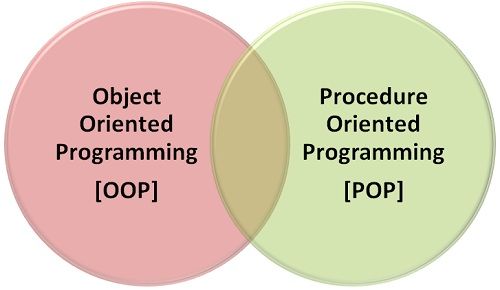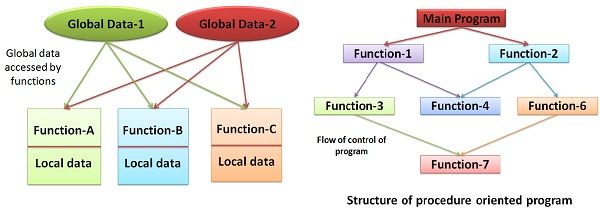 Procedure-oriented Programming(POP) and Object-oriented programming(OOP) both are the programming approaches, which uses high-level language for programming.A Program can be written in both the languages, but if the task is highly complex, OOP operates well as compared to POP. In POP, the ‘data security’ is at risk as data freely moves in the program, as well as, ‘code reusability’ is not achieved which makes the programming lengthy, and hard to understand. Large programs lead to more bugs, and it increases the time of debugging. All these flaws lead to a new approach namely “object-oriented programming”. In object-oriented programming’s main concern is given on ‘data security’; it binds the data closely to the functions which operate on it. It also resolves the problem of ‘code reusability’, as if a class is created, its multiple instances(objects) can be created which reuses the members and member functions defined by a class.
Procedure-oriented Programming(POP) and Object-oriented programming(OOP) both are the programming approaches, which uses high-level language for programming.A Program can be written in both the languages, but if the task is highly complex, OOP operates well as compared to POP. In POP, the ‘data security’ is at risk as data freely moves in the program, as well as, ‘code reusability’ is not achieved which makes the programming lengthy, and hard to understand. Large programs lead to more bugs, and it increases the time of debugging. All these flaws lead to a new approach namely “object-oriented programming”. In object-oriented programming’s main concern is given on ‘data security’; it binds the data closely to the functions which operate on it. It also resolves the problem of ‘code reusability’, as if a class is created, its multiple instances(objects) can be created which reuses the members and member functions defined by a class.
There are some other differences which can be explained with the help of comparison chart.
Content: OOP Vs POP
Comparison Chart
| BASIS FOR COMPARISON | POP | OOP |
|---|---|---|
| Basic | Procedure/Structure oriented . | Object oriented. |
| Approach | Top-down. | Bottom-up. |
| Basis | Main focus is on "how to get the task done" i.e. on the procedure or structure of a program . | Main focus is on 'data security'. Hence, only objects are permitted to access the entities of a class. |
| Division | Large program is divided into units called functions. | Entire program is divided into objects. |
| Entity accessing mode | No access specifier observed. | Access specifier are "public", "private", "protected". |
| Overloading/Polymorphism | Neither it overload functions nor operators. | It overloads functions, constructors, and operators. |
| Inheritance | Their is no provision of inheritance. | Inheritance achieved in three modes public private and protected. |
| Data hiding & security | There is no proper way of hiding the data, so data is insecure | Data is hidden in three modes public, private, and protected. hence data security increases. |
| Data sharing | Global data is shared among the functions in the program. | Data is shared among the objects through the member functions. |
| Friend functions/classes | No concept of friend function. | Classes or function can become a friend of another class with the keyword "friend". Note: "friend" keyword is used only in c++ |
| Virtual classes/ function | No concept of virtual classes . | Concept of virtual function appear during inheritance. |
| Example | C, VB, FORTRAN, Pascal | C++, JAVA, VB.NET, C#.NET. |
Definition of Object-oriented programming(OOP)
OOP’s main concern is to hide the data from non-member functions of a class, which it treats like “critical information”. Data is closely tied to the member functions of a class, which operates on it. It doesn’t allow any non-member function to modify the data inside it. Objects communicate with each other through member functions to access their data.
OOP is developed on the basic concept of “object”, “classes”, “data encapsulation or abstraction”,”inheritance”, and “Polymorphism/overloading”. In OOP, programs can be dived into modules by partitioning data and functions, which further can be used as templates for creating new copies of modules, if required.

Definition of Procedure oriented programming(POP)
POP is a conventional way of programming. Procedural programming is where the primary focus is on getting the task done in a sequential order. Flowchart organizes the flow of control of the program. If the program is large, it is structured in some small units called functions, which shares global data. Here the concern of data security arises, as there is an unintentional change in the program by functions.

Key Differences Between OOP and POP
- POP is a procedure oriented programming whereas, OOP is an object oriented programming.
- The main focus of POP is on “how to get the task done” it follows the flow chart to get the task done. OOP’s main focus is on data security as only the objects of a class are allowed to access the attributes or function of a class.
- The functions are small units of the large programs that execute to get the main task done. In OOP attributes and functions of the class are divided among the objects.
- In POP, there is no specific accessing mode to access attributes or functions in the program whereas, in OOP there are three accessing modes “public”, “private”, “protected”, that are used as an accessing share to access attributes or functions.
- POP does not support the concept of Overloading/polymorphism. OOP supports Overloading/Polymorphism a which means using the same function name for performing different functions. We can overload functions, constructor, and operators in OOP.
- There is no concept of inheritance in POP whereas, OOP supports inheritance which allows using the attribute and functions of other class by inheriting it.
- POP is less secure as compared to OOP because in OOP the access specifier limits the access to attributes or functions which increase the security.
- In POP if some data is to be shared among all the functions in the program is declared globally outside all functions. In OOP the data member of the class can be accessed through the member functions of the class.
- In POP there is no concept of the friend function whereas, in OOP there is a concept of friend function which is not the member of the class but because it is friend member it can access the data member and member functions of the class.
- There is no concept of virtual classes in POP whereas, in OOP the virtual functions supports polymorphism.
Conclusion
The flaws of POP arises the need of OOP. OOP corrects the flaws of POP by introducing the concept of “object” and “classes”. It enhances the data security, and automatic initialization & clear-up of objects. OOP makes it possible to create multiple instances of the object without any interference.
No comments:
Post a Comment
commnet here